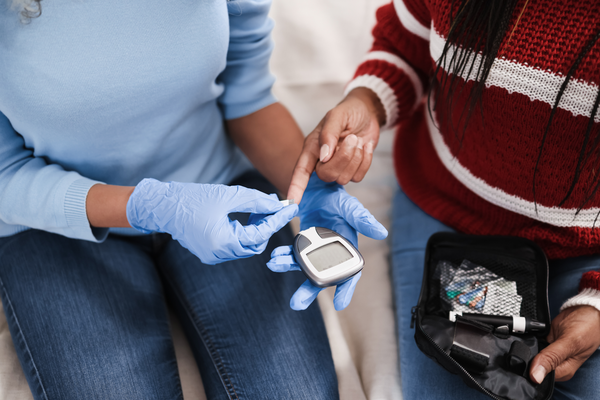August 12, 2014
Prediabetes describes the condition of someone who is on their way to developing diabetes. Before having diabetes, people usually have “pre-diabetes.” This is a new name for a condition in which blood glucose (sugar) levels are higher than normal but not yet high enough to be diagnosed as diabetes. A person with prediabetes cannot handle sugar as well as they should. Even though diabetes is not full blown, high sugar levels in prediabetes can be causing problems throughout the body. One of the main organs that can be damaged is the kidney.
People with prediabetes often have unrecognized chronic kidney disease (CKD), according to new research. In this large study, more than one third of the people with prediabetes were found to have two signs of kidney disease:
- protein in the urine (called albuminuria). Albuminuria is not normal.
- reduced estimated glomerular filtration rate (eGFR). This is a measure of how well the kidneys work; the eGFR tells the stage of kidney disease.
In the people with prediabetes, the stage of chronic kidney disease was just as advanced as people with diabetes. Many people with either prediabetes or diabetes were found to have stage 3 or 4 chronic kidney disease. There are 5 stages of chronic kidney disease. When the disease reaches stage 5, the person will need kidney replacement therapy, either transplantation or dialysis.
Join the NKF Blog Newsletter
Get inspirational stories and kidney disease resources delivered to your inbox every month. You'll gain practical insights and expert advice to help you better understand and manage your kidney health no matter where you are on your kidney journey. Subscribe today.
How many people have prediabetes?
The U.S. Department of Health and Human Services estimates that about one in four U.S. adults aged 20 years or older—or 57 million people—have pre—diabetes.
Without patients and their doctors taking action, prediabetes is likely to become type 2 diabetes in 10 years or less. People with prediabetes should know that the long—term damage to their body—especially to the heart, kidneys and blood vessels — may already be happening.
What are the risk factors for prediabetes?
Many of the risk factors for prediabetes are similar to those for chronic kidney disease, such as:
- High blood pressure
- High blood cholesterol
- History of cardiovascular disease
- Overweight and sedentary lifestyle
- Having a family background that is African American, Alaska Native, American Indian, Asian American, Hispanic/Latino, or Pacific Islander
In addition to these shared risk factors, unique risk factors for prediabetes include:
- Having a family history of diabetes
- Giving birth to a baby weighing more than 9 pounds or being diagnosed with gestational diabetes (diabetes during pregnancy).
If you have one of these risk factors, talk with your doctor about what testing is recommended for kidney disease and diabetes.
Is prediabetes a new condition?
No. It's a new name for a disorder doctors have known about for a long time. People on their way to developing diabetes have higher than normal blood sugar (glucose) levels. Pre-diabetes is a clearer way of explaining what it means to have higher than normal blood glucose levels. People with prediabetes are in danger of getting diabetes, and are at higher risk of chronic kidney disease and heart and blood vessel diseases. Giving it a new name helps people understand they have a chance to do something about getting diabetes. They can delay or reduce the risk of getting type 2 diabetes by eating better, exercising and losing excess weight.
Should I be tested for kidney disease if I have prediabetes?
This is a good question for your doctor. Most people with kidney disease do not know they have kidney disease. Many people who have prediabetes or undiagnosed diabetes have signs of kidney damage (like albuminuria) and/or reduced kidney function (measured by eGFR). Diabetes is the number one cause of kidney failure. Kidney damage occurs even before diabetes is full blown.
Tests for kidney disease include: a blood test to estimate your glomerular filtration rate (GFR); a urine test to find albumin; and blood pressure measurement. High blood pressure is a cause and consequence of chronic kidney disease.
Could I have pre-diabetes and not know it?
Yes. People with pre-diabetes often don't have symptoms. In fact, people with diabetes don't always have symptoms. Symptoms of diabetes include unusual thirst, a frequent desire to urinate, blurred vision, or a feeling of being tired most of the time for no apparent reason.
How is prediabetes diagnosed?
There are three different tests your doctor can use to determine if you have pre-diabetes:
- A1C (A-one-C) test is an abbreviation for hemoglobin A1C. This test measures your average blood glucose (sugar) over the last 3 months.
- The fasting plasma glucose test or
- The oral glucose tolerance test.
The blood glucose levels measured after these tests determine whether you have pre-diabetes or diabetes.
What can I do if I have prediabetes?
If you are found to have pre-diabetes, you now have an opportunity to reduce the risk of getting type 2 diabetes. Experts estimate that most people with prediabetes get the diagnosis of diabetes within 10 years, unless they make important changes. These changes are to:
- Lose 5 to 7% of their body weight (about 10 to 15 pounds for someone who weighs 200 pounds and about 8 to 10 pounds in someone who weighs 160 pounds);
- Eat a healthier diet and
- Get more physical activity. Physical activity helps muscle cells use blood glucose for energy by making the cells more sensitive to insulin.
By losing weight and being more physically active, people may avoid developing type 2 diabetes.
The Diabetes Prevention Program and other large studies have shown that people with pre-diabetes can often prevent or delay diabetes if they lose a modest amount of weight, eat better, and exercise.
What can I eat?
You should talk to your doctor and dietitian about the best choices for you. They recommend cutting fat, sugar, salt, and calories. They can help you make wise food choices with better nutrition. Many doctors recommend a “DASH” diet, which has been shown to affect the development of hypertension, diabetes, and other chronic diseases. The DASH diet stands for Dietary Approaches to Stop Hypertension, but it benefits other chronic diseases as well. There are 8 components of the DASH diet:
- more fruits and vegetables
- more nuts and legumes
- low-fat dairy products
- whole grains
- avoid salt and sodium
- use fats in small amounts
- no sweetened beverages or soda and
- limited red and processed meats (hot dogs, sausages, fast food, etc).
What if my prediabetes becomes diabetes?
If you have diabetes, you can do things to defend against kidney disease, heart disease, and stroke. Make some changes and live a long and healthy life.
Keep your eye on the ABC's of diabetes.
- A is for A1C The A1C (A-one-C) test is an abbreviation for hemoglobin A1C. This test measures your average blood glucose over the last 3 months. Aim to reach the suggested target: below 7.
- B is for blood pressure High blood pressure makes your heart and kidneys work too hard. By taking your prescribed medicines every day, you can help protect them. You want to reach a lower blood pressure target: below 130/80.
- C is for cholesterol You want to watch your bad cholesterol, or LDL, which can build up and clog your arteries. The suggested target is below 100. You want to raise your good cholesterol, or HDL, which helps keep your arteries unclogged.
The ABCs might be the ABCDs, by adding a “D” for “Do something”. Get out and exercise, change your diet, lose excess weight, follow your doctor's instructions, keep taking your medicines and, measure your blood sugar as advised. Pre-diabetes doesn't mean diabetes…yet.


















